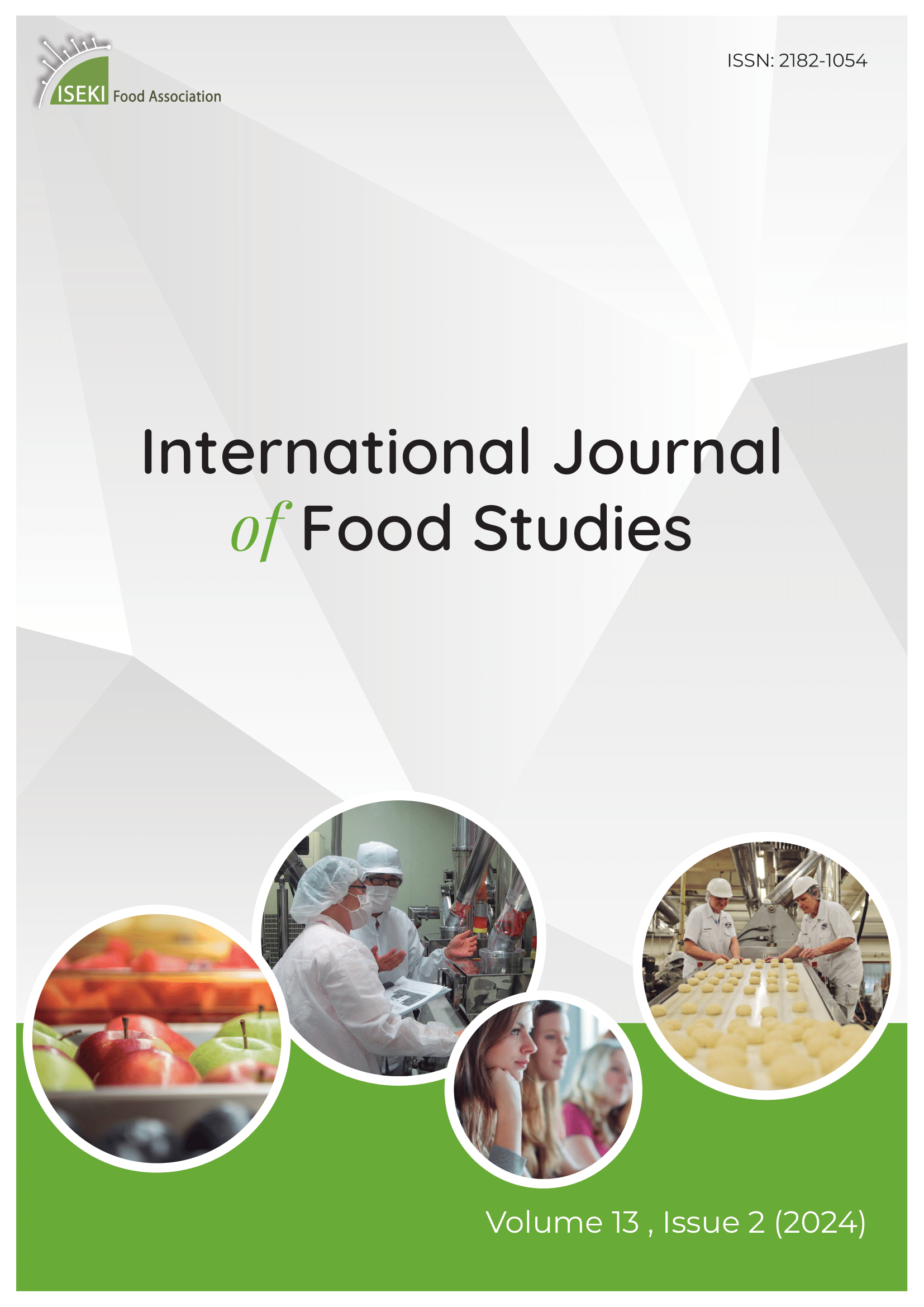Current issue

Volume 13, Issue 2, 2024
Online ISSN: 2182-1054
Volume 13 , Issue 2, (2024)
Published: 18.10.2024.
Open Access
All issues
Contents
18.10.2020.
Original scientific paper
Quality of postharvest strawberries: comparative effect of fungal chitosan gel, nanoparticles and gel enriched with edible nanoparticles coatings
This study compared, for the first time, the postharvest conservative action of edible fungal chitosan coatings (gel, nanoparticles and gel-nanoparticle) on the physico-chemical, sensorial and microbiological characteristics of strawberries. The nanoparticles were prepared by an ionic gelation method and characterized by dynamic light scattering and scanning electron microscopy. The antioxidant (DPPH* and ABTS*) activity of the edible coatings and the antimicrobial (macrodilution method) action against phytopathogenic fungi were verified. The nanoparticles had a size of 331.1 nm and a zeta potential of+ 34 mV. The gel, nanoparticles and gel+nanoparticles exhibited minimum inhibitory concentration values ranging from 4 to 5, 1.5 to 2.5 and 1.0 + 0.5 to 2.0 + 1.5 g.L-1, respectively. All the edible coatings exhibited antifungal action. All the coatings had high scavenging activity, especially the gel edible coating. The coatings, especially the gel+nanoparticles, decreased the weight loss, microbiological growth, soluble solids, maturity index and moisture loss of the strawberry and preserved the pH values, anthocyanin content, titratable acidity and sensory characteristics. Therefore, the use of chitosan edible coating containing nanoparticles can be a promising strategy to improve the post-harvest quality of strawberries.
Natália Melo, Maria Manuela Estevez Pintado, José Alberto da Costa Medeiros, André Galembeck, Margarida Angélica da Silva Vasconcelos, Viviane Lansky Xavier, Marcos Antônio Barbosa de Lima, Tânia Lucia Montenegro Stamford, Thatiana Montenegro Stamford–Arnaud, Miguel Angel Pelágio Flores, Thayza Christina Montenegro Stamford
18.10.2020.
Original scientific paper
Biodegradable film development by nisin Z addition into hydroxypropylmethylcellulose matrix for mozzarella cheese preservation
Currently, improvement of food preservation has been a substantial challenge for industries to increase shelf-life of products and to maintain food quality during storage. These goals are often tied to the sustainable tendency for use of eco-friendly packaging to store these products without loss of the packaging features. Therefore, the aim of this study was to produce biodegradable antimicrobial films by the incorporation of nisin Z peptide under different concentrations (0 %, 5 %, 10 %, 15 % and 20 % wt.) into hydroxypropylmethylcellulose (HPMC) matrices. The active film properties were evaluated in terms of their antimicrobial capacity in vitro, mechanical performance and microscopic characteristics. Hence, active films containing 10 % (wt.) of nisin Z and control films were placed in contact with sliced mozzarella cheese for eight days, and microbiological growth was monitored during storage. Nisin Z’s antimicrobial effects were observed against the Gram-positive microorganisms such as Staphylococcus aureus and Listeria innocua, regardless if the compound was free as a suspension or incorporated into HPMC matrices. However, the expected low action of nisin Z against Gram-negative bacteria, as reported in literature, was not observed since Salmonella enterica Choleraesuis’s growth was inhibited. Moreover, active films with added nisin Z (10 % wt.) were more effective than the control film to inhibit mesophilic microorganisms in mozzarella cheese during 8 days of storage. The mechanical properties of the films were not influenced by nisin Z incorporation, since the addition of the compound enhanced the active function without the loss of mechanical properties required for a good food packaging. These results suggest that biodegradable films produced by nisin Z addition into HPMC matrix are an excellent biomaterial for mozzarella cheese preservation.
Pedro Augusto de Freitas, Rafael R. A. Silva, Taíla V. de Oliveira, Raquel R. A. Soares, Nilda F. F. Soares
24.02.2021.
Original scientific paper
Study of Antimicrobial, Antioxidant and Cytotoxicity Properties of Selected Plant Extracts for Food Preservative Applications
An attempt has been made to evaluate antimicrobial, antioxidant and cytotoxicity properties of extracts from onion (Allium cepa L.), garlic (Allium sativum), leaves of guava (Psidium guajava), papaya (Carica papaya), tea (Camellia sinensis), baen (Avicennia alba) and keora (Sonneratia apetala), respectively to apply as natural preservatives for tomatoes. The air-dried plant materials of the respective plant species were subjected to ethanol-methanol extraction, concentrated and stored at 4 °C before use. The extracts were dissolved in 95% ethanol for analysis of antioxidant and antimicrobial properties. Of the extracts tested, tea extracts showed the highest zone of inhibition against several pathogenic bacteria (E. coli 35.0±3.2 mm; P. aeruginosa 29.3±2.6 mm; S. typhi 28.4±2.1 mm and S. pyogenes 27.7±3.7 mm) using the disc diffusion method. In regard to DPPH free radical scavenging assay, keora and guava extracts showed the highest percentage of radical scavenging activity with the values of 89.64± 0.18 and 89.39± 0.88, respectively, which were in agreement with higher total antioxidant capacity (TAC) of these extracts obtained by the phosphomolybdenum method. Brine shrimp lethality bioassay for cytotoxicity assessment showed LC50 of 132.54 ± 18.99 µg/mL for the leaf extract of keora which was found to be most toxic among all studied extracts. The initial results indicated that the extracts could be used for food preservative applications based on the antimicrobial, antioxidant and cytotoxicity properties of the tested extracts. However, efficacy, stability and safety issues need to be addressed with both in vitro and in vivo studies.
Md. Nazrul Islam, Md Nazrul Islam, Wahidu Zzaman, Md Morsaline Billah
18.10.2020.
Original scientific paper
Research, development and capacity building for food and nutrition security in sub-Saharan Africa
This paper focuses on research, development, and capacity building in relation to food and nutrition security (FNS) in sub-Saharan Africa (SSA). It looks at human capacity, education, teaching and learning, women empowerment, research, innovation and technology, research, indigenous knowledge (IK), institutional aspects, infrastructure, information and communication technologies (ICT), policies and finance. Professional bodies exist in many countries and the extent to which they engage in FNS awareness creation differs. Food and nutrition insecurity continues to affect people in Africa’s 54 nations where the population is expected to double by 2050 with the expected doubling of food production to keep pace with population growth. Within the continent there is a substantial number of human capacity professionals who are global leaders in food, nutrition and related professions. Some research organisations in the continent directly or indirectly benefit from grants administered by developed economies but a challenge exists with brain drain and ageing of qualified and experienced experts. Increasing educational need, coupled with the growing population necessitates attention to ensuring a sustained supply of highly trained, adequately equipped and qualified professionals in the relevant fields of food and nutrition sciences. Higher educational institutions exist in especially those that fall within the 500 in world universities ranking. Research activities take place in the continent along with the translation of research outputs into commercialisable products. Research towards transforming agriculture for improved livelihoods is taking place in different parts of the continent. Education, governance, gender and rural development are the key challenges. Income growth and the impacts of climate change on food production have contributed to food insecurity. ICTs can play an important role for FNS. Strengthening research, development, capacity building and industry cooperation are critical for FNS in Africa.
Afam I. O. Jideani
18.10.2020.
Original scientific paper
Estimation of the dietary exposure of polycyclic aromatic hydrocarbons in Syria and their health risks assessment
In this work, the exposure of people, through their diet, to polycyclic aromatic hydrocarbons (PAHs) has been assessed for the urban, rural, and general populations in Syria. The food categories consumed have been divided into major groups, and the health risk assessment on dietary exposure of PAHs determined in each food category. For this purpose, two approaches were used: incremental lifetime cancer risk (ILCR) and margin of exposure approach (MOE). The results showed that each of the following food categories: oils and fats, meat and meat products, vegetables, and cereals dominantly contribute in the dietary exposure of PAHs. Also their MOE values are the lowest. Additionally, they have higher ILCR values. Therefore, these groups are a main risk source to health. On the other hand, the dietary exposure of PAHs in each of urban, rural and general populations was of low health concern, whereas their ILCR values reached to 10E-05 in total food categories, nevertheless it remains lower than serious risk level (ILCR>10E-04). This work is the first study that is dealing with dietary exposure of PAHs and their health risk assessment in Syria.
Hour KRAJIAN
18.10.2020.
Original scientific paper
Assessment and Evaluation of Student Learning Through a Project-Based Assignment on Note by Note Cooking
Many innovative teaching and learning methods are used in higher level education including project-based learning (PBL). Since 2012 a PBL assignment project has been undertaken by master students of the Advanced Molecular Gastronomy module at Technological University Dublin (TU Dublin). The aim is to stimulate student learning and creativity by using Note by Note cooking in a PBL assignment while at the same time complying with the requirements of the annual International Note by Note contest which is held in Paris, France. Direct and indirect assessment methods were used to assign individual grades and to gather student feedback about the module. The direct methods were both formative and summative. The indirect method used was a student feedback questionnaire. Results to date (2012-2019) showed that 92% of learners successfully passed the module. However, further evaluation of individual assessment results revealed that most students achieved higher scores for finding and using resources, asking further questions and developing their own answers than for analysing, synthesising and evaluating information (P≤0.01). Overall students were happy with the module content and said that they learnt about Note by Note cooking, chemical compounds, researching, independent-thinking and perseverance. In future students should carry out a more in-depth analysis, synthesis and evaluation of information.
Róisín M. Burke, Pauline Danaher
24.02.2021.
Original scientific paper
Effect of Emulsifier Diacetyl Tartaric Acid Ester of Mono- and Diglycerides (DATEM) and Enzyme Transglutaminase on Quality Characteristics of Rice Bran Croissants
Rice bran (RB) is a good source of dietary fibre. Addition of rice bran into croissant interferes with the gluten formation of dough and hence affect the physicochemical properties of croissant. The effect of RB addition on physicochemical properties of croissant were determined by using 0%, 10% and 15% RB. Besides, additives such as emulsifiers and enzymes can be used in pastry to enhance the physicochemical properties of croissant. Diacetyl tartaric acid ester of mono-diglycerides (DATEM) and transglutaminase (TGase) were used respectively on 0%, 10% and 15% RB to investigate the effect of such additives on physicochemical properties of croissant. Increased % RB and DATEM, produced a significant decrease in specific volume, together with a significant increase in colour, hardness and chewiness. With increased % RB, TGase caused significant increase in colour, hardness and chewiness but significant decrease in specic volume. The overall moisture sorption isotherm curves of the croissant belong to the Type III isotherm, also known as Flory-Huggins Isotherm (J-shaped). The critical aw obtained from the Guggenheim-Anderson-de Boer (GAB) equation showed that the shelf life of croissants were not positively impacted by the addition of DATEM and TGase and the addition of RB did not cause any significant positive effects on quality characteristics of croissants.
Wan Zunairah Wan Ibadullah, Aw Ying Hong, Mahmud Ab Rashid Nor-Khaizura, Nor Afizah Mustapha, Z. A. Nur Hanani, Mohammad Rashedi Ismail-Fitry, Anis Shobirin Meor Husin
24.02.2021.
Original scientific paper
Effect of Taro (Colocasia esculenta) Enrichment on Physicochemical and Textural Properties of Cake
Taro is a plant widely produced in tropical areas for its underground corms and it is used mainly as a vegetable. Its physicochemical, sensory properties and health benefits led to its use in value-added products. The cake is a high value-added bakery product and it needs a lower amount of gluten protein, therefore, taro flour (TF) was supplemented in wheat flour (WF) at different levels (10, 20, 30 and 40%). In connection with this, the incorporation of taro flour into wheat-based products has been reported to increase their nutritional and textural quality. The taro-supplemented cake showed higher mineral and fiber content, however, reduced caloric value. It was observed that taro supplementation reduced gluten and protein content and had higher oil and water binding capacity, therefore suitable for cake preparation. Taro cake had improved texture and sensory characteristics in comparison to wheat cake. It can be concluded that addition of taro for cake preparation improves nutrition and quality characteristics, therefore, it can be recommended to use taro for cake preparation.
Anuj Saklani, Ravinder Kaushik, Prince Chawla, Naveen Kumar, Mukul Kumar
24.02.2021.
Original scientific paper
Chemical Characteristics and Sensory Properties of Novel Snacks Produced with Okara Fortified with Omega-3 from Fish Oil
The aim of the present work was to develop a new soy-based food product and evaluate its chemical and sensory properties. A soy-based snack was mixed with rice (Oryza sativa), fortified with eicos-apentaenoic acid (EPA) and docosahexaenoic acid (DHA) Omega-3 fatty acids from sh by-products in encapsulated and emulsion form. Soy beans were subjected to grinding processes, maceration in pure distilled water, filtration and pasteurization, to obtain vegetable drinks and generate solid residue. Finally, a sensory analysis of the product obtained was carried out. The snacks protein content was around 17%. From the sensory evaluation, it could be concluded that the snacks with 50% of okara had great acceptability and the addition of Omega-3 was also acceptable. So, okara represents an excellent raw material that can be utilized for dietary protein fortification. On the other hand, it proposes based on soy and fish by-products allow sustainable development and contribute to the economy of each sector.
Trinidad Sandra Álvarez, Daniela Lorena Lamas
24.02.2021.
Original scientific paper
The Effect of Seaweed (Eucheuma cottonii) Flour Addition on Physicochemical and Sensory Characteristics of an Indonesian-Style Beef Meatball
The objective of this work was to study the effect of seaweed (Eucheuma cottonii) our addition on physicochemical and sensory characteristics of an Indonesian-style beef meatball. Seaweed flour (SF) was added to meatball batter at 0% (CON), 2.5% (SF2.5), 5.0% (SF5) and 7.5% (SF7.5) in weight/meat weight (w/w) basis. Proximate composition (moisture, crude protein, crude fat, crude fiber and ash content), pH, cooking loss, hardness, water-holding capacity, instrumental color and sensory properties (color, texture, aroma, taste and overall acceptability) of the boiled meatballs were evaluated. The effect of seaweed our addition was very significant (P<0.01) on moisture, crude fat, crude fiber, ash, cooking loss, hardness, water holding capacity, lightness (L*), yellowness (b*) and all sensory properties, and was significant (P<0.05) on crude protein, pH and the redness (a*) of a boiled Indonesian-style beef meatball. The addition of seaweed flour at more than 2.5% resulted in darker meatballs, with less protein and fat, and a stronger seaweed aroma. The results suggest that seaweed flour could be added at 2.5% (w/w) to produce an Indonesian-style beef meatball with enhanced ber content.
Aris Sri Widati, Djalal Rosyidi, Lilik Eka Radiati, Happy Nursyam











